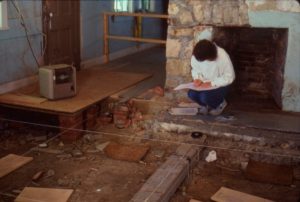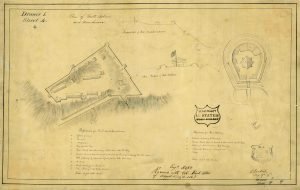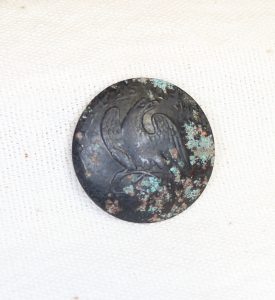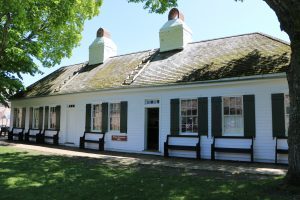
One of the more unusual archaeological projects to take place at Fort Mackinac was an excavation that took place under a standing structure. When the Officers’ Wood Quarters was restored in 1986, the floorboards of the west room were removed and an archaeological excavation took place. Some excavation also took place outside the building during the restoration of the south porch that same summer. The excavation was carried out by a University of South Florida field school directed by Dr. Roger T. Grange, Jr. The resulting data was analyzed by Laura Dee Clifford for her master’s thesis, Excavations at the Officers’ Wooden Quarters at Fort Mackinac, Michigan. This blog post is based on her work.

The main question the project was designed to answer was when and by whom was the Wood Quarters built? It first appears on a plan of the fort drawn in 1817 by Major Charles Gratiot.
In addition to serving as an officers’ barracks, with three apartments, the building later housed the post hospital, a sutler’s store, laundresses’ quarters, a reading room and library, general storeroom, billiard room, and canteen. After the military period it was remodeled into an artist’s studio in the 1920s. It was restored back to its military appearance in 1933-34 and housed museum exhibits.

Clifford was able to answer the puzzle of the building’s origin through the presence of a United States Infantry button in the construction layer. The button dates from between 1812 and 1815. Since the British occupied Fort Mackinac throughout the War of 1812, this button could not have arrived at the fort until the Americans returned July 18, 1815. The Wood Quarters were present by the time Gratiot drew his map in 1817. Therefore, the building must have been built in 1816 by the Americans.

After the 1986 restoration was complete, the west room was furnished as the 1880s billiard room. Like all the buildings inside Fort Mackinac it, is open to the public from early May through late October. In 2022, Fort Mackinac will open for the season on May 3.









